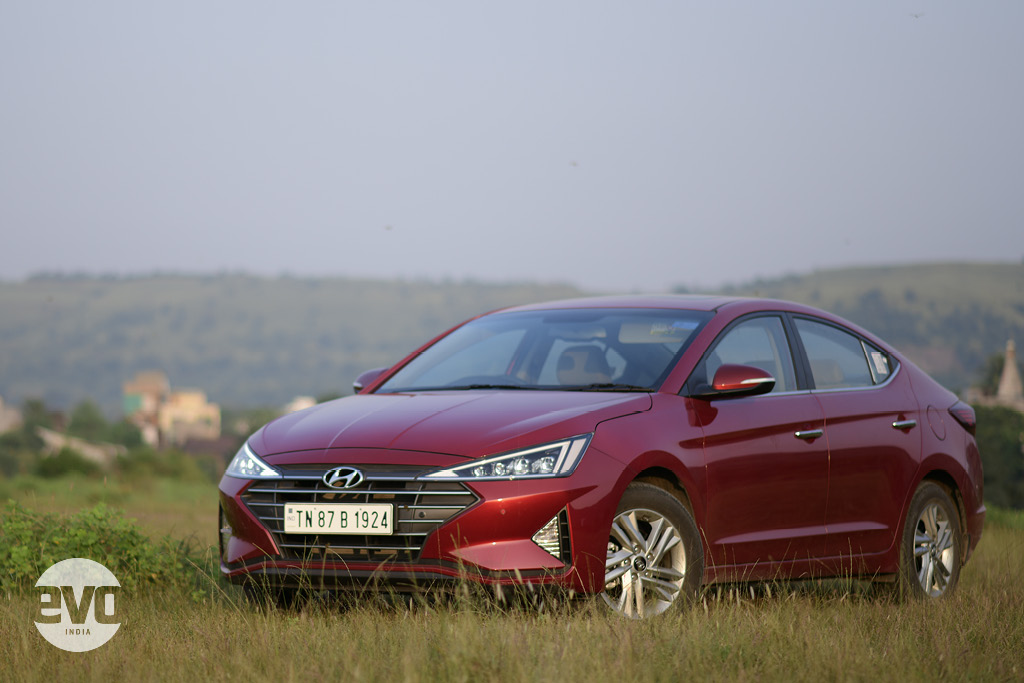2019 Hyundai Elantra facelift - First Drive Review
BS6 compliant petrol engine, Bluelink connectivity, and a much sharper looking front end are the primary upgrades on the 2019 Elantra, to take on the Civic

With all the action in the SUV segments one does not hear much about D-segment sedans like the Honda Civic, not to forget the Skoda Octavia and Toyota Corolla Altis. But the Korean manufacturer is keeping the faith and here is the 2019 Hyundai Elantra and comes close on the heels of the recent big (small car) launches – the Venue and Grand i10 NIOS. It’s main rival is the Civic, the newest car in the segment, the Altis will soon be petrol only with BS-6 emission norms, and an all-new Octy is coming next year.

Styling of the new 2019 Hyundai Elantra
The most visible change on the Hyundai Elantra is its redesigned front end. It’s much sharper than before and flaunts LEDs all-around (front and rear). The triangular DRLs especially are amongst the first things that you notice.

The headlamps are quad-projector units on each side, and they’re embellished with chrome surroundings that add a premium feel to the overall styling. The hexagonal cascading grille too is upgraded and is in sync with the Fluidic Sculpture 2.0 design language. If you’re a student of design you’ll know that Hyundai has now moved to ‘Sensuous Sportiness’ as seen on the new Sonata — this will most likely follow with the Elantra gets a full model change which is not what we have here.

The side profile of the 2019 Hyundai Elantra gets the least amount of visual changes and with no sheet metal changes the silhouette and shoulder lines are carried over. The 10-spoke alloys though are new and look sportier. At the rear, the wraparound taillamps are now full LED units.

More features on the inside
The cabin layout of the 2019 Hyundai Elantra is unchanged. What adds a sense of airiness and space are the dual tone beige and black interiors. The quality of materials used remains top-notch with nothing feeling cheap or out of place. There’s a bunch of additional kit packed inside the Elantra’s cabin that makes a big difference. With the addition of Bluelink, the Elantra is now the first connected sedan in the country.

Just like the Venue, the Elantra also gets 33 connected features. Owners can access a host of features via the Bluelink smartphone app – start/stop the engine, set the climate control, locate the car, check vehicle health, geo-fencing, create monthly health reports, amongst many more. The wireless charger works well (no fast-charging sadly), and the new 8-speaker Infinity music system, with adequate base and crisp sound, is excellent. Android Auto and Apple CarPlay are now offered as standard across all three variants.

How does the Elantra ride?
As the dimensions of the Elantra remain the same, there’s ample headroom at the rear and leg-space too isn’t an issue. In fact, the rear seat is properly plush and allied to the Elantra’s great ride, long distance trips will be hassle-free. The suspension doesn’t feel overly stiff not too soft and Hyundai’s engineers have retained that good balance in the Elantra updated. Not much has changed in terms of the suspension components or layout and the Elantra can still flatten out ruts and bumps with the poise.

On the handling front the Elantra has good body control and inspires confidence, and doesn’t shy away from attacking corners. For those who’ll look to be chauffer driven, they’ll have no complaints regarding the back-seat comfort and ride of the Elantra. That said, the Elantra is no driver’s car. The steering lacks feedback and is very light and vague most of the times. It weighs up just adequately at higher speeds and the inputs don’t feel precise. The handling benchmark remains the Octavia and in comparison the Elantra has more body roll and the steering is not as nice either but the gap is actually not that large.

No diesel, only petrol power for now
Hyundai has phased out the diesel engine from the Elantra and the sedan will only come with a BS-6 compliant 2.0-litre, four cylinder naturally aspirated petrol engine that makes a healthy 150bhp and 192Nm of torque. It can be either mated to a six-speed manual or a six-speed torque converter automatic. In terms of power delivery, the 2019 Elantra retains the traits of the car it replaces. It can pull cleanly from as low as 2000rpm in third gear and cruises comfortably. There are four modes for the engine: normal, sport, eco and smart, with the latter automatically choosing an optimal mode after analysing driver inputs. Put it into sport mode and it feels properly brisk, holding the revs a bit longer getting to triple digit speeds without any extra effort. The automatic we drove shifted in a smooth and jerk-free manner provided you’re light footed. Pin the throttle and the shifts aren’t as quick as a twin-clutch but then that’s to be expected. NVH levels are good and being a petrol there’s no clatter or anything seeping in to cabin.

Verdict
It does cut a striking shape, that’s for sure but I am not fully convinced by the the 2019 Elantra. Then again styling is personal and most in the office like the bold design. However, Hyundai has always been generous with features and that along with its BS6 compliant 2.0-litre petrol engine are strong USPs working in favour of the Elantra facelift (what works against it though is the lack of a diesel engine). The sedan rides and handles well and doesn’t pretend to be an enthusiastic driving machine which it isn’t. It delivers well where it’s expected to, which is comfort, convenience and top-notch features making for a tough rival to the Honda Civic. Also, at Rs 15.89 lakh, the Elantra undercuts the Civic (Rs 17.93 lakh), by more than rupees two lakh, clearly scoring an edge over the Japanese sedan.


